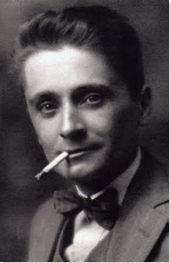Summary of Jean Metzinger
As one of the leading lights of the Cubist movement, Metzinger's standing in the development of the avant-garde rest both on the excellence of his paintings and his theoretical writings. A member of the so-called Salon Cubists, he was, more so than Braque and Picasso, responsible for bringing Cubism to the attention of the general public and, with Albert Gleizes, co-wrote the first, and most significant, treatise on Cubism, Du Cubisme. Unlike Gleizes, who remained steadfast in his commitment to the movement, however, Metzinger was given more to formal experimentation and this can be seen in an oeuvre that overlaps Pointillism, Fauvism, Cubism and even elements of Surrealism. Balancing his creative and philosophical output with a number of significant teaching posts, in later life he turned away from theoretical writing in favor of poetry.
Accomplishments
- Braque and Picasso had set a standard for a Cubism that didn't allow for the "frivolity" of color or movement to distract from their mission to create a multi-perspective art. Metzinger's work (like that of the other Salon Cubists) was much more open to the possibilities of color as a means of capturing a sense pictorial dynamism. His efforts, which made Cubism more amenable to a sceptical general public, helped bring about a transformation in attitudes towards avant-garde art and put Cubism at the center of the international art scene.
- Metzinger was a member of Groupe de Puteaux. The group staged the first ever major Cubist exhibition, La Section d'Or. The exhibition was complemented by Metzinger and Gleizes's hugely influential book, Du Cubisme. It was, and remains, the only description of early Cubism written by artists who actively shaped the future of modern art.
- Metzinger earned renown for his exploration of "mobile perspective". His pursuit of multiple aspects of a single subject paralleled those of the Danish physician Niels Bohr who proposed that for a viewer to gain a complete understanding of an object they must be able to examine it simultaneously from various viewpoints. Bohr introduced Metzinger to the idea of the fourth dimension in painting (and the functional role of the viewer played in the understanding of an artwork) and, after reading Du Cubisme, Bohr purchased Metzinger's 1911 painting, La Femme au Cheval, where it took pride of place on his office wall.
- Metzinger emerged during the heights of Neo-Impressionism and Divisionism and his proto-Cubist works carry the influences of Cézanne, Seurat and Gauguin in subject matter and in the fragmented daubs of his brush. He created dazzling mosaic illusions that were illuminated by his "daring" use of color and signalled what would be a life-long commitment to the idea that art should not be a faithful imitation of life.
The Life of Jean Metzinger
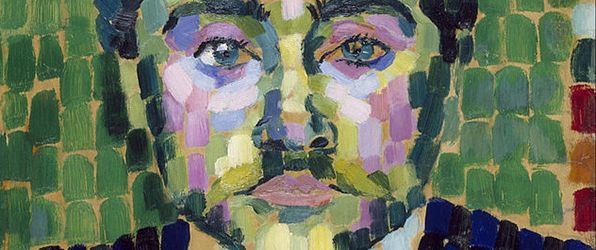
For Metzinger painting was a language with its own syntax and laws but for him the modern artist "must never lose sight of the End" - which is not "the subject, nor the object, nor even the picture - the End, it is the idea"
Important Art by Jean Metzinger
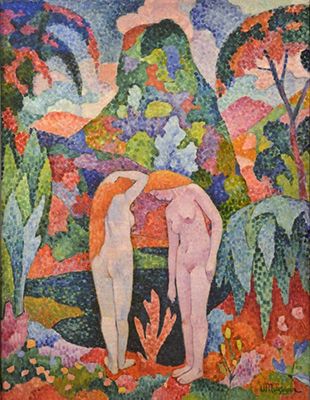
Baigneuses: Deux nus dans un paysage exotique
Painted shortly after Metzinger's arrival in Paris, this work depicts two female nudes, one facing the viewer, the other with her back turned, in a verdant and tropical setting. It is Fauvist in its use of color yet Divisionist in its composition. Whilst the figures are treated with natural tones on their skin and hair, the setting uses bold and typically Fauvist hues - reds, blues, greens, oranges - to convey warmth and exoticism. Metzinger used thick brushstrokes and impasto to create a mosaic-like composition: the divided and fragmented brushstrokes creating "syllables" from which Metzinger constructed a coherent language of the painting. As in a mosaic, the foreground and background are flattened and there is minimal perspective, much like the work of Seurat.
Baigneuses is consistent with other works by Metzinger during the height of his Neo-Impressionist and Divisionist period. As well as obvious nods to Seurat, this work shows the influence of both Paul Cézanne and Paul Gauguin in its subject matter and its rendering. The fragmentation of brushstrokes that come together to create a coherent whole pre-empts Metzinger's later Cubist style (with its precision and dependence on geometry and structure). Writing in 1907, the artist said of these cubes of color: "I make a kind of chromatic versification and for syllables I use strokes". Crucially, this painting clearly aligned Metzinger with other modern artists in Paris at this time in its refusal to reveal nature "as seen", but rather "as experienced", by the artist/viewer.
Oil on canvas - Carmen Thyssen-Bornemisza Collection, Madrid
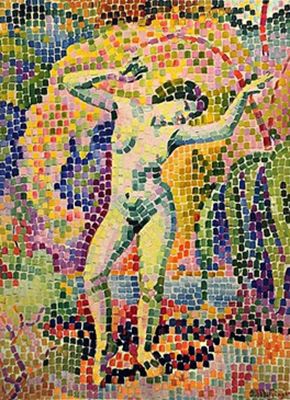
La danse, Baccante
Using large blocks of a similar size but contrasting bold colors, Metzinger pieces together a mosaic-like scene of a classical female nude in a natural setting. The title of the work denotes a classical subject matter and reflects the artist's admiration for Ingres and David: Baccantes were the female followers of Bacchus, the Roman god of wine, typically portrayed nude and dancing. The cubic brushstrokes give the work a syllabic rhythm and create a geometric field which lacks depth, rendering the concept of perspective or a foreground/background divide irrelevant.
This painting signifies a step beyond the Divisionism and Neo-Impressionism of Signac, Seurat, or Cross, as Metzinger moves closer to the Cubist preference for geometric order. Whilst the mythological narrative is one common to classical artists, Metzinger renders the Baccante in a very modern way. The denial of perspective, the static pose of the figure, and the use of unnatural and daring colors show Metzinger's rejection of the belief that art should be an imitation of life. The American art critic Gelett Burgess was particularly touched by this work describing it as a "gorgeous mosaic of pure pigment, each little square of color not quite touching the next, so that an effect of vibrant light should result".
Oil on canvas - Kröller-Müller Museum, Otterlo
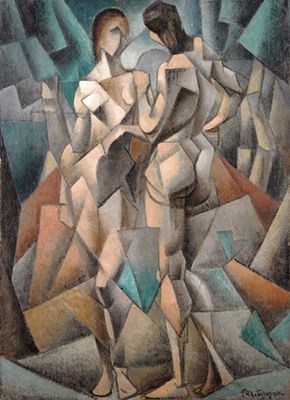
Deux Nus
The term Analytical Cubism was first introduced in 1920 by the art dealer Daniel-Henry Kahnweiler in his book Der Weg zum Kubismus (The Rise of Cubism). Though it followed the publication of Metzinger and Gleizes's Du Cubisme (by some eight years), it is considered the first authoritative text on the historical development of Cubism and in it Kahnweiler broadly separated out the Analytical phase (1910-12) from the Synthetic phase (1912-14) of the movement. The Analytic phase, to which Deux Nus belongs, described a process whereby the artist fractured the subject into multi-layered, angular, surfaces and by so doing brought their still lifes and portraits close to a point of total abstraction (the Synthetic Phase is defined rather as a "flat" style based on picture collage that often incorporated fragments of found everyday objects).
Metzinger returns to the subject of the female nude in this Analytic work which depicts a pair of women: one forward facing; the other turned away. As with previous works, the artist has merged together the foreground and background to create one indistinguishable plane. However, contrary to his earlier works on this theme, here the setting is undeterminable and not obviously exotic, and the vivid Fauvist colors have been subdued (as was the preference of Braque and Picasso) by a palette of light greens, grays, and browns. The figures are shown from multiple, fragmented viewpoints simultaneously, in what Metzinger himself termed "mobile perspective".
Deux Nus was first exhibited at the 1911 Salon des Indépendants, alongside the work of Gleizes, Le Fauconnier, Delaunay, and Léger. In his role as the secretary of the Salon, Le Fauconnier ensured that these five artists' works were hung together, resulting in the term "Cubism" being introduced into the lexicon of modern art for the first time. Following the exhibition, the critic Roger Allard wrote of this piece: "This canvas exudes a real intimacy, thanks to the integration of the setting into the principal strokes". Deux Nus confirms Metzinger's move away from Divisionism, although he still uses cubes to build a coherent whole picture and indicates a preoccupation with mathematics. Around this time in his career, Metzinger was starting to write about the theory behind his art, linking it to the principles of non-Euclidean (referring to a lack of parallel lines) geometry.
Oil on canvas - Gothenburg Museum of Art, Gothenburg
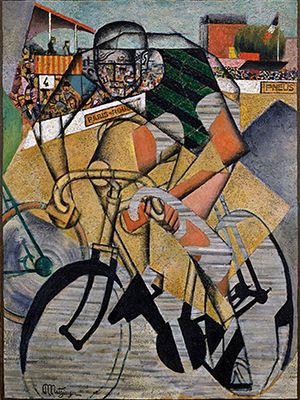
Au Vélodrome
The Sotheby's specialist Thomas Boyd-Bowman described Metzinger as "a bit of a magpie, and amalgamator of the innovations of Cubism and Futurism" and that this work "exemplified his adept synthesis of avant-garde principles to vividly evoke the speed and dynamism of the modern age". Indeed, Au Vélodrome depicts the finish of the 1912 Paris-Roubaix cycling race and its winner, Charles Crupelandt. The foreground is dominated by Crupelandt wearing a green and black striped cycling jersey on a black bicycle. Through different shapes and transparencies, the crowds in the background can be seen through the figure of the cyclist. The excitement of the finish line and impression of speed is seen both in the cyclist's pose (leaning over the handlebars) but also in the inclusion of the spinning back wheel of another racer, just out of view to the left of the canvas. Here the artist makes full use of Cubist tropes, such as geometric shapes, multiple planes, and changing perspectives.
Metzinger's use of transparency and multiple viewpoints simultaneously creates the impression of a series of photo-finish frames displayed together. The painting blurs foreground and background, but also time: the track visible through the wheels and Crupelandt's body hints at the past and present moment fused as one. This portrayal illustrates Metzinger's interest in quantum mechanics and mathematics at this time in his career, further recognized by the curator Erasmus Weddigen's interpretation that the number four seen in the crowd of spectators alludes to Metzinger's theories of the fourth dimension in art. It was exhibited for first time at the Third Exhibition of Contemporary French Art at the Carstairs Gallery in New York in 1915, where it was sold to the American collector John Quinn. Quinn sold it a decade later to the American art dealer J. B. Neumann, who in turn sold it to the prolific American socialite and art collector Peggy Guggenheim in 1945, where it still resides in the permanent collection of her museum in Venice, Italy.
Oil on canvas - Peggy Guggenheim Collection, Venice
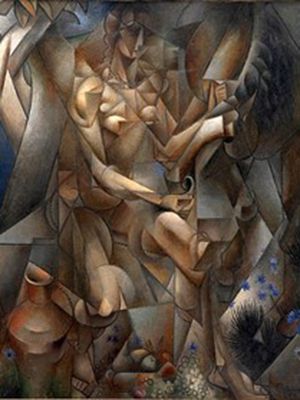
La Femme au Cheval
In this painting, Metzinger continues his exploration of the "mobile perspective" by portraying a female nude from multiple viewpoints. La Femme au Cheval conforms in fact to many of the stylistic preferences - multiple planes, volumetric, both rectilinear and curvilinear, forms - one would expect to see in an example of Analytic Cubism. The figure is shown feeding a horse to the right of the canvas; to the left geometric planes create an unidentifiable setting in which the woman and horse are immersed. At the figure's feet are some familiar objects: a vase, plants, and flowers. Metzinger's preference here is for a more subdued color palette - though one can still see splashes of vibrant color in the inclusion of the blue flowers - using sensuous and earthy tones to create a sense of light bouncing from the central figure.
Metzinger's portrayal of multiple aspects of a subject on one canvas has parallels with the Copenhagen interpretation of quantum mechanics, as proposed by the Danish physician Niels Bohr. Bohr's theories considered the relationship of the observer and the idea that a complete understanding of an object may require examining it from various points of view. His work influenced Metzinger's considerations of the fourth dimension in painting and the active role of the viewer in the understanding of an artwork. Exhibited at both the Salon des Indépendants and Salon de la Section d'Or, the painting was acclaimed by many, including Apollinaire, who subsequently featured it in his only book The Cubist Painters, Aesthetic Meditations (1913). This work later even played a supporting role in the development of 20th century science when, in 1932, Bohr purchased the painting, seeing it as the expression of his "fourth dimension" theory of quantum mechanics in art.
Oil on canvas - Statens Museum for Kunst, Copenhagen
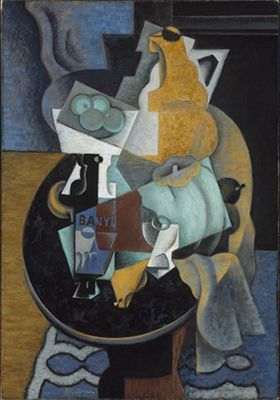
Melon et compotier
Metzinger was at the forefront of a style that became known as Crystal Cubism (given its name by the poet and critic Maurice Raynal). Though it started to take shape during the war years, Crystal Cubism is linked with the so-called "Return to Order" (or "Interwar Classicism") that followed in the wake of the chaos of World War One. Led by Metzinger and Gleizes, Crystal Cubism also included "purer" Cubist paintings by Braque, Picasso and Juan Gris and it was a style typified by reduced and more colorful geometric planes.
In this example, Metzinger utilizes the common Cubist form of the still life, hitherto associated mostly with the works of Picasso and Braque. This scene displays a bowl of fruit, glass, and carafe, built together with a strong focus on geometry to create a sense of interconnectedness. The multi-faceted planes in this work are more angular than Metzinger's past work and makes more use of block colors rather than shading. The image is flat and uses thick, expressive, brushstrokes, while the layered objects carry a sense of glass-like transparency.
Following the First World War, Metzinger confirmed his move towards more traditional subject matter (such as still lifes). Indeed, this work was exhibited at Léonce Rosenberg's Galerie de l'Effort Moderne in Paris in 1919, following Metzinger's signing of an exclusive contract with the art dealer. As such it represented the new appetite for a more ordered style of Cubism (and a more structured style of modern art generally). Though the Crystal style did not allow for a sense of dynamism or mobile perspective, Metzinger's geometry remains non-Euclidean (non-parallel) and he, in the ever-defining spirit of Cubism, continues to deny his viewer any traditional sense of perspective.
Oil on canvas - Museum of Fine Arts, Boston
Femme au Faisan
Having secured a fifteen year contract with Léonce Rosenberg's gallery, Metzinger had enough financial security to allow him to push the boundaries of Cubism beyond its Crystal (or Pure) phase. Metzinger's work became much more individualistic as he began to introduce a greater realism into his work. It was a shift that allowed for scenes of domestic/urban life rendered in contrasting bold colors. As The Sotheby's specialist Thomas Boyd-Bowman describes, "Forms in these works become progressively streamlined and contain geometrically simplified elements that embody the Art Deco aesthetic of the early 1920s and 30s as well as the impact of the Purism of Ozenfant and Le Corbusier during this time". Boyd-Bowman aligned Metzinger's works of this period in fact with the general "search for classical beauty and balance that characterized the so-called rappel à l'ordre [call to order]" that was influencing "many avant-garde artists working in Europe in the aftermath of the First World War".
The historian and curator Joann Moser added that " the unusual iconography of these works distinguishes them from the work of any other artist and engages the viewer's imagination to a degree that many [of Metzinger's] earlier works do not [and that the] introduction of spatial complexities ... counterbalances the strongly decorative appearance of these works". Boyd-Bowman points out, however, that "The bold use of primary colors and incorporation of Neo-Classical architectural references underscore the dialogue between Metzinger and his friend and contemporary Fernand Léger" and deferred to Léger's biographer Douglas Cooper who drew comparisons with "the conceptual underpinnings" of Femme au Faisan with Léger's work of the same period which had "exchanged the monumental for the living".
Oil on canvas - Private Collection
Biography of Jean Metzinger
Childhood
Jean Metzinger was born into a family of military prominence. His great-grandfather, Nicolas Metzinger, had served under Napoleon Bonaparte, whilst a street in Jean's birthplace of Nantes was named after his grandfather, Charles Henri Metzinger, a French general who conquered Madagascar. Following the early death of his father, Eugène François Metzinger, Jean Metzinger shunned his military heritage, choosing instead to follow in the steps of his mother, Eugénie Louise Argoud, who worked as a professor of music. Nevertheless, the art historian and curator Daniel Robbins proposes that this military background made Metzinger an "unusually sardonic" character.
During his childhood, Metzinger developed a keen interest in music, painting and mathematics, a grouping which would prove pivotal to his painting style. At the age of seventeen, Metzinger enrolled as a student at the Académie Cours Cambronne in Nantes. Here he attended the classes of the portrait painter Hippolyte Touront who taught in a traditional and academically rigorous manner.
Early Training and Work
In 1903 (after having completed his formal studies) Metzinger submitted three paintings to the (jury-free) Salon des Indépendants all of which sold. With the money he made he was able to move to Paris. Metzinger was warmly received in the Parisian art scene and exhibited regularly from the moment he arrived. Indeed, he participated in the first Salon d'Automne (like the Salon des Indépendants as an alternative, if slightly more selective, challenge to the "official" Paris Salon) exhibition of 1903. His works of this period were largely French landscapes and seascapes which he had painted around the regions of Caen, Le Croisic in Brittany, and Arromanches in Calvados.
Once settled in Paris, Metzinger started to experiment more and more with Neo-Impressionism, taking his lead from figures such as Georges Seurat and Henri-Edmond Cross. Indeed, Neo-Impressionism was enjoying a surge in popularity in France following a large Paul Signac exhibition in December 1904, a major Seurat retrospective at the Salon des Indépendants in 1905 and a successful solo exhibition by Cross at the Galerie Druet, also in 1905. Metzinger's more daring use of geometry and color soon caught the attention of the avant-garde art dealer Berthe Weill who become Metzinger's chief benefactor.
Metzinger's style soon evolved from the detailed Divisionist style towards the larger, freer brushstrokes and more simplified forms associated with the rise of Fauvism. His offering of eight paintings at the 1905 Salon des Indépendants confirmed this Fauvist shift and he quickly became associated with artists such as André Derain and Henri Matisse (even assisting the latter in the hanging of the Salon). In 1906 Metzinger was himself elected to the Salon's hanging committee, and then, in 1908, he cemented his growing reputation by exhibiting with the Fauvists at the Salon de la Toison d'Or in Moscow.
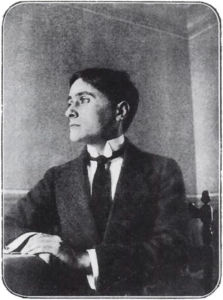
For Metzinger, the first decade of the twentieth century was defined by the contacts he made in Paris and the artistic experiments he undertook in the company of fellow avant-gardists. In 1906, for instance, Metzinger formed a close friendship with Robert Delaunay - who, through his faceted, vibrant, compositions, and their celebration and the idea of the belle époque, gave rise to the Orphism movement - painted each other's portraits. These pieces experimented with the color effects associated with Divisionism, and which, according to critics like Louis Chassevent, helped distinguish Metzinger's work from other Fauves and Neo-Impressionists.
Also in 1906, Metzinger met Albert Gleizes at the Salon des Indépendants and soon thereafter visited his studio in Courbevoie. This was the beginnings of a lifelong friendship with Gleizes who was also experimenting with fractured forms and new perspectives in painting. Metzinger exhibited again with the Berthe Weill gallery in 1907 with Robert Delaunay, and in 1908 with André Derain, Fernand Léger and Pablo Picasso. It was during this period he made the acquaintance of the poet and writer Guillaume Apollinaire with whom he shared an instant intellectual connection. Metzinger rounded off this most successful of decades with his marriage to Lucie Soubiron on December 30, 1909.
Mature Period
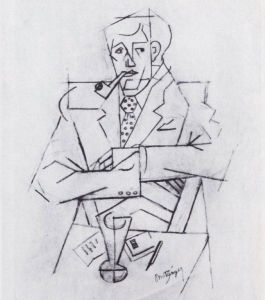
In 1910 Metzinger presented his Portrait of Guillaume Apollinaire and the Salon des Indépendants. The portrait was hailed by the sitter as the first ever Cubist portrait and he wrote of the artist: "Metzinger aims high. He undertakes - a little coldly perhaps - tasks from which not many masters would be able to extricate themselves". Metzinger's portrait was not, however, positively received by everyone who attended the 1910 Salon. The art critic Louis Vauxcelles wrote for instance that Metzinger, and his contemporaries Gleizes, Léger, Delaunay and Henri le Fauconnier, were "ignorant geometers, reducing the human body, the site, to pallid cubes".
Gleizes claimed that it was not until their coming together at the Salon d'Automne later in 1910 that this group "seriously discovered one another and understood what affinities brought us together". From this point onward the group regularly socialized and exchanged ideas, discussing, amongst other things, which artists of the past influenced them most and what the future of painting might hold for them. Favorites were Jacques-Louis David and Jean-Auguste-Dominique Ingres, and Gleizes said of these meetings: "How many conversations took place among us apropos of these great ancestors, how many times we endeavored to guess at the genesis of their works!". In 1910 Metzinger published an article in the journal Pan about Picasso and Braque and their avant-gardist experiments with multiple viewpoints of a single object. It anticipated by two years one of the most important treatise in the history of modern art, Du Cubisme, written with his friend Gleizes.
In 1911 the group participated in the notorious Salle 41 at the Salon des Indépendants. Though confined to a single room (Salle 41) it was the first group exhibition of Cubist painters. It earned the group the name of the "Salon Cubists" (and did not feature works by Picasso or Braque who were bound by exclusive contracts to the influential art dealer Daniel-Henry Kahnweiler). The exhibition introduced Cubism to the general public and caused a scandal. The critic Phillip Barcio writes that following the Salle 41 exhibition, the Salon Cubists "began meeting formally in the Paris suburbs, either at the studio of Albert Gleizes in Courbevoie, or at the home of the Duchamp brothers in Puteaux. That second meeting place gave the Groupe de Puteaux, or Puteaux Group, its name. At these meetings, the group had deep discussions of what Cubism is and is not, and outlined both its roots and its goals".
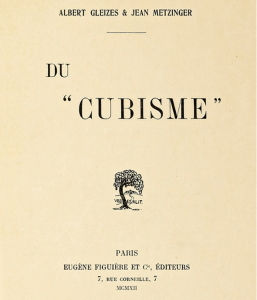
Barcio adds that by 1912 Groupe de Puteaux had "a fully formed conception of their method [and] so to mark the moment they mounted the first ever major Cubist exhibition: La Section d'Or [at the Galerie de la Boétie in Paris]". It was as a supplement to La Section d'Or that Gleizes and Metzinger conceived of Du Cubisme; what Barcio describes as " the first - and only - explanation of Cubism written by early Cubist artists themselves".
Du Cubisme would make a significant impact on the art world and was later translated into several languages and illustrated by black and white reproductions by eleven artists - Metzinger, Gleizes, Picasso, Braque, Paul Cézanne, Fernand Léger, Marcel Duchamp, Juan Gris, Francis Picabia, André Derain and Marie Laurencin - all of whom had been influenced by, or had fully embraced, the Cubist philosophy. In the text itself, the authors mostly explained the principles and techniques of revealing a subject through multiple perspectives as a means of capturing time, movement, and fluidity.
But the authors also defended the will of the modern artist to test the boundaries of art: "That the ultimate end of painting is to reach the masses, we have agreed; it is, however, not in the language of the masses that painting should address the masses, but in its own language, in order to move, to dominate, to direct, and not in order to be understood. It is the same with religions. The artist who abstains from all concessions, who does not explain himself and who tells nothing, accumulates an internal strength whose radiance enlightens all around ... for the partial liberties conquered by Courbet, Manet, Cézanne, and the impressionists, Cubism substitutes a boundless liberty".
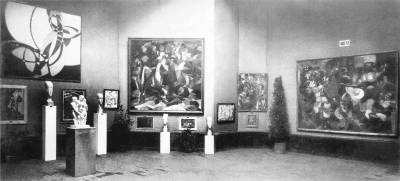
Following the publication of Du Cubisme, Metzinger was appointed to the faculty of the Académie de la Palette, which at the time was under the directorship of Le Fauconnier. Among Metzinger's students at the Académie were the Russian avant-gardists Varvara Stepanova and Lyubov Popova. The following year, Metzinger took on additional teaching positions at the Académie Arenius and the Académie de la Grande Chaumière. He continued to exhibit in the principal salons of Paris and in 1913 joined part of the famous Exhibition of Cubist and Futurist Pictures (better known as The Armory Show), which toured the United States for a year, introducing American audiences to European modernism.
In 1913, Apollinaire wrote his own treatise on Cubism: Les Peintres Cubistes: Méditations Esthétiques. In the text, Apollinaire described Metzinger as "the third Cubist", after Picasso and Braque. Attributing four different types of Cubism - scientific, physical, orphic, and instinctive - Apollinaire placed Metzinger in the first category, as his work was characterized by a sense of purity, of "rigorous logic", and of art which extends deeper than conventional vision. Apollinaire wrote: "a painting by Metzinger always contains its own explanation...and is something unique it seems to me, in the history of art".
The First World War caused great disruption to the Parisian avant-garde as artists scattered internationally amidst the chaos: Gleizes initially enlisted in the French army before moving to New York in 1915; Matisse relocated to the French Riviera and Le Fauconnier to the Netherlands. Metzinger, on the other hand, remained and worked as a medical orderly, continuing to evolve his artistic work (as best he could, given the circumstances) throughout the war. He continued to exhibit (albeit irregularly) during the First World War. His most notable exhibition was at the Annual Exhibition of Modern Art at the Bourgeois Gallery in New York, organized by the critic Walter Pach, in the spring of 1916. This was one of the largest showcases of modern art in the United States and married the work of the burgeoning American avant-garde with paintings by key figures from Europe including Matisse, Picasso, and Marcel Duchamp.
Late Period
During the war and post-war years Metzinger helped develop a style that would be later coined by the French poet and art critic Maurice Raynal as "Crystal Cubism". Characterized by larger overlapping and interweaving geometric planes, Crystal Cubism was a move away from the investigations into perspective which typified Metzinger's earlier work. It was a stripped down form of Cubism (and was given various other names including classical Cubism, pure Cubism, advanced Cubism and pure Cubism) that placed most emphasis on the flat surface and overlapping planes. In a letter to Gleizes dated July 4, 1916, Metzinger wrote of his strides forward in his theories of painting: "The geometry of the fourth space has no more secrets for me ... everything is number". He detailed the need to measure and reduce shape and space in order to render it comprehensible. These rules were suited to more than just painting, but to architecture, music, and the other visual arts too: "all lasting art is never anything more than a mathematical expression of the relations that exist between what is inside and what is outside, the self and the world", he told his good friend.
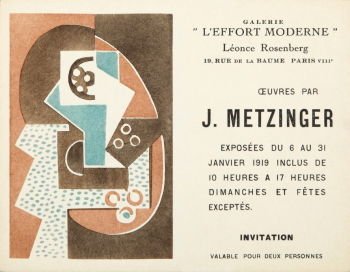
Metzinger signed a three-year "exclusive-rights" contract with the art dealer Léonce Rosenberg who already represented other Crystal Cubists - including Gleizes, Gris, and Henri Laurens - on similar contracts. Rosenberg was the proprietor of the newly opened Galerie de l'Effort Moderne, which, following the end of the First World War, quickly became the epicenter for modern art in Paris. The art historian Peter Brooke wrote: "As post-war reconstruction began, so too did a series of exhibitions at Léonce Rosenberg's Galerie de L'Effort Moderne: order and the allegiance to the aesthetically pure remained the prevailing tendency. The collective phenomenon of Cubism once again - now in its advanced revisionist form - became part of a widely discussed development in French culture. Crystal Cubism was the culmination of a continuous narrowing of scope in the name of a return to order; based upon the observation of the artists relation to nature, rather than on the nature of reality itself". Rosenberg organized a series of solo shows for his artists, including shows for Metzinger in January 1919 and February 1921. This success in Metzinger's post-war career was sadly not mirrored in his personal life. His wife Lucie died in 1918, and his daughter committed suicide shortly thereafter.
Once his three-year contract with Rosenberg expired, it was extended to a fifteen-year arrangement, the added financial security allowing Metzinger to be freer to experiment. Indeed, throughout the 1920s he began to include more realistic elements in his work, including depictions of still life, urban life, and direct references to technology. His love of experimentation saw his work incorporate elements of Surrealism, yet despite difficulties of fixing his work within a dedicated movement, Metzinger remained ever consistent in his use of bold color and concerns with geometry, perspective, and dimension. It was around this time too that he met the French artist Suzanne Phocas with whom he became romantically involved. The couple married in 1929 and continued to inspire one another's work throughout the decades (Phocas painted Portrait of Metzinger in 1926, and Metzinger painted Suzanne Phocas au sombrero in 1940, for instance).
In his later career Metzinger continued to exhibit as widely and as frequently as possible. His popularity in London, for example, can be seen in his solo shows at both the Leicester Galleries in 1930 and the Hanover Gallery in 1932. Following on from the group shows he had previously participated in in the United States, Metzinger also secured a late career retrospective at the Arts Club in Chicago in 1953. He ceased writing about artist theory in favor of poetry, and in 1947 published a collection titled Ecluses. In addition to developing and honing his own work, Metzinger carried on teaching late into his career, taking up a new position at the Académie Frochot in Paris in 1950. He died in Paris on November 3, 1956.
The Legacy of Jean Metzinger
In his essay accompanying the exhibition catalogue Jean Metzinger in Retrospect held at the University of Iowa Museum of Art in 1985, Robbins suggested that modern art history has been unkind to Metzinger by focusing too much on Braque and Picasso. Robbins noted that Metzinger's art should be considered in relation to his own theories and techniques, rather than through constant comparison to those artists not in his direct circle. The art historian Richard West agreed, citing a confusion between Cubism as a style of painting and as an aesthetic theory. He noted that it was "unwise ... to regard every deviation from the style of Picasso and Braque as a 'misunderstanding'".
Bearing this in mind, we can consider Metzinger's legacy as one of the defining founders of Cubism, both in his participation in the Parisian pre-war art scene, but also in his collaboration with Gleizes on Du Cubisme. Indeed, the curator Erasmus Weddigen describes Metzinger as "an artist who is central to our understanding of Cubism". His involvement in one of the most important art movements of the twentieth century has been recognized and celebrated both posthumously, but also at the time, in press reviews and in the writings of his friend and contemporary Apollinaire. Metzinger's dabbling with a range of art styles - including Divisionism, Post-Impressionism, and Surrealism - as well as his numerous teaching posts mark him as an artist who continually sought to express new ways of depicting objects in space, and new ways to challenge the viewer.
Influences and Connections

-
![Robert Delaunay]() Robert Delaunay
Robert Delaunay -
![Albert Gleizes]() Albert Gleizes
Albert Gleizes -
![Guillaume Apollinaire]() Guillaume Apollinaire
Guillaume Apollinaire -
![André Derain]() André Derain
André Derain - Berthe Weill
-
![Fernand Léger]() Fernand Léger
Fernand Léger -
![Pablo Picasso]() Pablo Picasso
Pablo Picasso -
![Lyubov Popova]() Lyubov Popova
Lyubov Popova ![Henri Le Fauconnier]() Henri Le Fauconnier
Henri Le Fauconnier![Varvara Stepanova]() Varvara Stepanova
Varvara Stepanova
- Léonce Rosenberg
-
![Cubism]() Cubism
Cubism -
![Surrealism]() Surrealism
Surrealism - Crystal Cubism
Useful Resources on Jean Metzinger
- Jean Metzinger in RetrospectBy Joann Moser
- Modern Artists on ArtBy Robert L. Herbert
- Cubism and its historiesBy David Cottington
- CubismBy Guillaume Apollinaire and Dorothea Eimert
- Painters of the Section d'Or: The Alternatives to CubismBy Richard West
- Theories of Modern Art: A Source Book by Artists and CriticsBy Herschel B. Chipp
- The Fourth Dimension and Non-Euclidean Geometry in Modern ArtBy Linda Dalrymple Henderson
 Ask The Art Story AI
Ask The Art Story AI